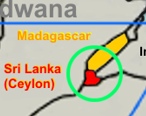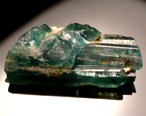Grandidierite Info
Back to Grandidierite
 |
| Pangaea |
Until appr. 230 mya Sri Lanka resp. Ceylon and Madagascar belonged to one landmass, called Pangaea. So it's not surprising that grandidierite is found on both islands. The todays deposits (Kolonne and Andrahomana) for larger grandidierite crystals were only appr. 60 km apart in Pangaea!
History
Grandidierite was discovered in 1902, at Andrahomana / Ranopiso Department / Anosy Region / Tuléar Province in SE Madagascar. Its discoverer, Antoine François Alfred Lacroix (1863 – 1948), described it in the same year, and named it in honor of the French naturalist and explorer Alfred Grandidier (1836 - 1912).
The crystal structure of grandidierite was described by Moore and Stephenson in 1968 (Stephenson, D.A.; Moore, P.B.; Acta Crystallographica, Section B, 24 (1968), p. 1518 - 1522, "The crystal structure of grandidierite", (Mg,Fe)Al3SiBO9, Locality: Fort Dauphin, Madagascar).
The history of the first known transparent grandidierite is documented: In May 2000, the Canadian gemologist Murray Burford bought an uncut, transparent stone in Ratnapura / Sri Lanka. This alledged "serendibite" from the Kolonne area / Uva province / Sri Lanka was strongly trichroic: colorless, green and blue.
After the purchase the crystal was cut into a 0.29 ct gem, and sent to the German gemologist Dr. Karl Schmetzer for further examination. The refractive index as well as the specific gravity underpinned Burford's assumption that the mineral could be grandidierite. The results of this examination resulted in an article in Gems and Gemology ("The First Transparent Faceted Grandidierite, From Sri Lanka" by Karl Schmetzer, Murray Burford, Lore Kiefert, and Heinz-Jürgen Bernhardt").
In May 2000, Murray Burford sold the gemstone to the former director of the Swiss Gübelin Laboratory, Dr. Eduard J. Gübelin.
Color and Quality
 |
| Grandidierite * |
Larger grandidierites from Madagascar seem to be usually at best translucent, those from Sri Lanka can be transparent. Well-colored, clean stones are practically unavailable. Carat prices cannot be clearly fixed but USD 2,000 per carat for smaller, translucent, faceted stones from Madagascar seem to be not unusual.
* Photo by kind permission of © www.civilminerals.com, Josh Baimel.
⇐ Intro Page ⇐ Gemstones ⇐ Grandidierite